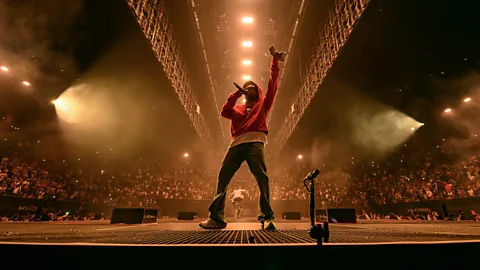 Getty Images
Getty ImagesAhead of Kendrick Lamar’s headline performance at the Super Bowl half-time show in New Orleans, we explore the rapper’s journey from the unforgiving streets of Compton to pop culture ubiquity.
« I’m not sure why I’m infatuated with death? » ponders a fiery and fed-up Kendrick Lamar on fan-favourite song Sing About Me, I’m Dying of Thirst. Sounding like he’s on his knees pleading to the man in the sky, the always-probing rapper finally answers his own question: « Maybe it’s because I’m a dreamer and sleep is the cousin of death! »
The song considers how an inner-city experience within a racially-divided US tends to be based around constantly grappling with feelings of impending doom: a toxic cycle that’s difficult to break free of. Filled with chest-deep empathy; a combination of hyper-animated lyrical perspectives (including a hopeless young man lost in gang activity as well as a sexually-abused girl damaged due to the foster care system); and an underlining morose wit, these raw, confessional lyrics signify why the Compton, Los Angeles rapper is regarded as one of hip-hop’s greatest ever songwriters.
The esteemed North Carolina rap producer 9th Wonder – who composed arguably the 20-time-Grammy-winning MC’s most experimental song with the three-act psychodrama of DUCKWORTH – told me back in 2023: « Kendrick Lamar is more like a documentarian than an MC. Kendrick chooses to rap about everything and everyone across the social strata. People might call it ‘woke’ or ‘deep’, but I think of it as straight-up reporting. Some rappers leave out a certain section of people in their lyrics, right? Well, Kendrick tries to rap from everyone’s perspective. »
The Pulitzer Prize-winning artist – who will perform as the half-time headliner for this Sunday’s Super Bowl at the New Orleans Superdome, with R&B star SZA confirmed as a guest – is that rare artist capable of making you see through the eyes of a troubled soul searching for salvation (How Much A Dollar Cost? reimagines God as a homeless man on Skid Row; Auntie Diaries considers the struggles of a transgender relative).
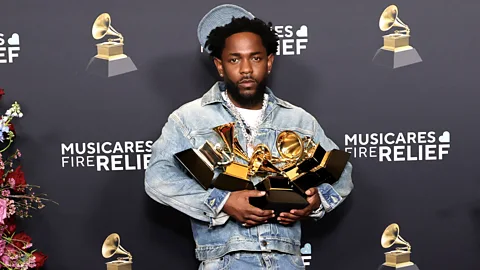 Getty Images
Getty ImagesHe can also consistently create loose, trunk-rattling hood anthems (see Money Trees) that convert highly chantable regional slang terms into trending words. For example, aside from a brilliant DJ Mustard beat that sonically feels like a tank blasting out quaking g-funk basslines while riding out to war, it’s fair to say Lamar’s urgent 2024 single tv off also went viral due to the hilarious yet highly-meme-able way the lead artist screamed out the word: « Mustarrrrrrrrrddddddddddd! »
Such was the success of this moment that Heinz are releasing a limited run of condiments, essentially turning Lamar’s battle cry ad-lib into a slogan to sell mustard for hot dogs. This illustrates how the artist has always been able to consistently juggle rapping about social injustice – even making a song with an earworm refrain (« We’re gonna be alright! ») that became an anthem for the global Black Lives Matter protest movement – with approval from corporate and mainstream America.
Lamar adopts different guises much like his hero Tupac Shakur, playing both preacher and soldier – giving weight to both Martin Luther King’s pacifism (LOVE), but also Malcolm X’s « by any means necessary » approach to politics (The Blacker The Berry). It is ultimately this duality and versatility that makes the artist the perfect choice for this Sunday’s Super Bowl half-time show, says Marcus J Moore, the music journalist and author behind The Butterfly Effect: How Kendrick Lamar Ignited The Soul of Black America. « Sadly, there’s still a segment of the [American] population that doesn’t consider rap a viable genre in music, despite its popularity, » he tells the BBC. « Such thinking suggests racism and classism, but with Kendrick Lamar, he’s the type of rapper who can make fans out of anyone. He’s a rapper’s rapper with a pop sensibility on stage. And while he’s tremendous on his own, he’s also had the benefit of guesting with bigger stars like Beyoncé and Taylor Swift. I think Kendrick has done a great job over the years of making himself undeniable. »
The path to the Super Bowl
To understand what Lamar’s upcoming Super Bowl performance might look like, you must go back to the artist’s humble origins. Raised on 1612 West 137th Street in Compton, Los Angeles, Lamar was surrounded by a community filled with members of rival gangs the Bloods and the Crips, that always felt on the verge of chaos. One of his earliest memories was of the 1992 Watts riots, which were triggered by anger around the filmed beating of Rodney King by LAPD officers and the fact a trial ultimately failed to result in any tangible convictions. More than 50 people lost their lives because of this uprising.
« There was smoke everywhere and my dad had a bunch of stolen car rims [he had looted] in the back seat he took from the Compton Swap Meet, » Lamar reflected in an interview with Signed Media. « My pops and my uncle were both involved in the Watts riots! LA is very sensitive and prideful of its people. We literally burned down our old neighbourhoods because of our anger over Rodney King. »
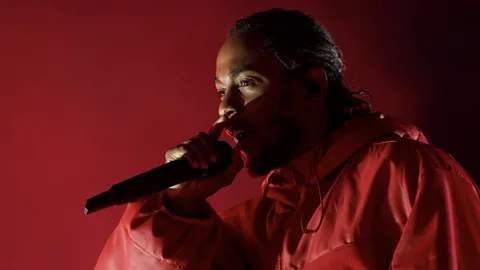 Alamy
AlamyThis rebellious spirit seeped directly into Lamar’s raps, with the artist getting sharper and sharper with each new mixtape and album release. It was 2011’s Section.80 that really turned industry heads, thanks to its playful tongue twisters (Rigamortus) and cryptic revolutionary songs (HiiiPoWeR) that dared people in Compton to « get off that slave ship [and] build your own pyramids ». Turning the heads of Dr Dre and Interscope Records, Section 80 was quickly followed by Lamar’s stunning major label debut LP, 2012’s good kid, m.A.A.d city.
Almost instantly heralded as a classic, the album’s three-dimensional, Dickensian storytelling reflected the tug-of-war experience of Lamar’s own childhood, where staying on the righteous path was a constant battle, especially when drive-by shootings were going on outside the family’s living room window. One of the key factors that made this Top Dawg Entertainment (the label that also hosts Doechii, SZA, and Schoolboy Q) record so great, according to 9th Wonder, was how it subverted gangsta rap cliches. « Some rappers do come from good homes with loving moms and dads! » he says. « Not everyone comes from a hardback struggle, or has to be a bad kid just because they come from a bad place. Kendrick knows the power of telling simple American stories about ordinary people doing their best. »
The importance of no album sounding the same as the last seemed to be a rule Lamar followed to the letter. In the years that followed his debut, he consistently took bold left turns, experimenting with avant-garde jazz on 2015’s To Pimp a Butterfly and a psychedelic stadium rap sound (PRIDE) on 2017’s DAMN. Arguably the biggest risk came with 2022’s double album Mr Morale & The Big Steppers, where Lamar brutally dissected his own psyche, admitting to cheating on his partner while touring overseas in Scandinavia and urging fans not to treat his raps too much like dissectible prophecies.
« The cat is out the bag, I am not your saviour! » was one of many of this project’s fall-on-your-own-sword lyrics, while the sound felt far more wounded and piano-based than previous iterations. With last year’s swaggering GNX album, however, Lamar seems to be most preoccupied with having fun, using the project as a victory lap for gutter Los Angeles rap and its ability to « squabble up » to invaders. Although it wasn’t featured on the project, the aforementioned five-Grammy-winning Drake diss Not Like Us definitely set the sharp-tongued tone that GNX possesses.
« Artists of Kendrick’s stature don’t usually rock the boat [and change their sound too radically] once they become famous, » says Moore. « But he’s done so with many of his releases, no matter how popular the previous albums were. He’s encouraged others to take creative risks for their music. I think, more than anything, this courage has helped change popular music. »
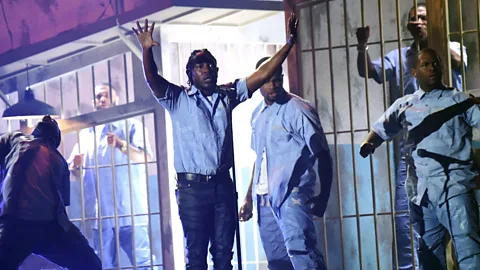 Getty Images
Getty ImagesMoore also credits Lamar’s ability to turn big performances into public statements that dominate social media conversation for cultivating such a crossover popularity. For the 2016 Grammys, for example, Lamar’s performance evoked the chains of slavery and America’s prison-industrial complex, as the rapper tap-danced alongside prisoners. By hiring Lamar, then, the NFL are sure to make an enduring live statement, much as they did with Beyoncé’s Hurricane Katrina-referencing Super Bowl performance from 2016. « I would prepare for anything! » predicts Moore. « If there’s any message that could emanate from Kendrick’s Super Bowl performance in New Orleans, I think it could be about the wildfires in Los Angeles and the city’s resilience. »
Seb Joseph, a marketing expert and editor at Digiday, believes the NFL’s decision to have Lamar as a half-time performer is supposed to reflect the changing values of their brand and business itself, which has endured accusations of racism in the past. He says it doesn’t matter if Lamar doesn’t have a song with a catchy chorus embedded as deeply in the collective psyche as say Purple Rain or Crazy in Love, because his selection for the Super Bowl « isn’t a risk – it’s a statement. »
Joseph adds: « If previous Super Bowl performers like Prince, Beyoncé and Madonna embodied pop ubiquity, Kendrick represents something just as powerful: cultural gravity. His music isn’t always designed for casual singalongs but rather it’s built for reflection, resistance and resonance. And in a moment when the NFL is still navigating its own complicated relationship with race, protest and black artistic expression, Kendrick isn’t just an artist – they’re inviting a movement to the main stage. »
‘A high-stakes stage’
It’s well understood that Lamar can help the NFL with its image problems, but the bigger question mark is around whether he will perform the Drake diss track. For many it’s a song that reflected a changing of the guard in mainstream rap supremacy and solidified Lamar at the very top of the competitive ladder. Crowning it the best song of 2024, Pitchfork’s Paul A Thompson wrote: « In the third verse, Kendrick casts Drake as a parasite who leeches off of younger, more inventive rappers in a quest for pyrrhic streaming statements. But by that point he’s already turned the biggest pop star on the planet into a punchline. »
The Canadian artist has an ongoing legal action against his and Lamar’s shared label Universal Music for releasing the song, but with Not Like Us now a five-time Grammy winner it’s hard to imagine it not being performed. Could a half-time Super Bowl performance featuring the song represent a risk to all the lucrative advertisers? Not according to Digiday’s Joseph.
« The song has transcended the beef. It’s fun, it’s infectious and it’s already been embraced far beyond the hip-hop world. Instead of just a diss track, it’s a cultural jolt – one that taps into regional pride, black joy and the communal energy that makes music feel alive. Brands love to co-opt hip-hop culture when it’s convenient. They’ll put rap lyrics on ad campaigns or with tweets; partner with artists for limited-edition sneakers’ and drop hip-hop-inspired Super Bowl commercials – all while keeping a safe distance from the actual violent tensions that shape the genre. »
With or without Not Like Us making an appearance, Kendrick Lamar is risking a lot by even gracing that stage. « The Super Bowl halftime show isn’t just a performance – it’s the single biggest branding opportunity in music. It’s a 12-minute global ad for an artist’s catalogue, cultural impact, and marketability, all broadcast to an audience of over 100 million people, » says Joseph.
« And here’s the kicker: performers don’t get paid! Instead, the exposure itself becomes the currency, often translating into massive streaming hikes, album sales and brand deals. Take Rihanna in 2023: her streams rose 640% after her performance, and Fenty Beauty reportedly pulled in more than $5 million in media impact value from that subtle but game-changing mid-show makeup touch up. But with the rewards come massive risks. »
Joseph continues: « The Super Bowl is a high-stakes, zero-margin-for-error stage where the scrutiny is relentless, the expectations sky-high. If an artist miscalculates, whether it’s the energy, the production or the cultural moment they’re stepping into, the fallout can be brutal. »
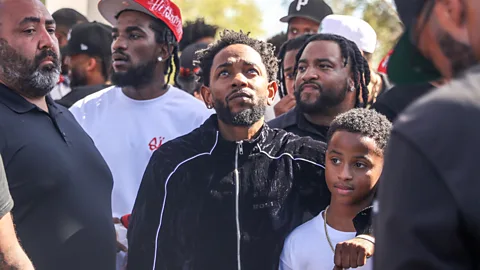 Getty Images
Getty ImagesMoore admits some of Lamar’s day one fans might see a contradiction in an artist who has a hit single, Swimming Pools, criticising hip-hop alcoholism also performing at a show where alcohol brands pay millions for advertising slots. His advice? Embrace Lamar for who he is now, not in the past. « Sure, some of his core fans might see his Super Bowl performance as a sell-out move, but I would encourage those listeners to go back and revisit his 2022 album, Mr Morale & The Big Steppers, where he shot back against the notion of being a paragon of virtue, » Moore says.
« Though listeners may want him to be the same artist and person he was on albums like good kid, m.A.A.d. city and To Pimp a Butterfly, they have to realise that was a decade ago, and if they want that guy, they have to play those albums. »
Whatever the fallout from Sunday’s performance might be, it will at the very least represent something special for the people of Compton, with a good kid from a mad city rubber stamping his musical legacy. Joseph just hopes to see Lamar perform Alright, believing the protest song’s simple message of perseverance is needed now more than ever before.
Joseph concludes: « At a time when history feels like it is repeating itself, when the same battles for justice and dignity are being fought yet again, Kendrick standing on that stage, leading millions in the chorus of « We gon’ be alright, » would be a powerful message. It would say: ‘we’re still here… and we’re not going anywhere.' »
The Super Bowl LIX takes place on Sunday 9 February.





:max_bytes(150000):strip_icc():focal(1105x162:1107x164)/Taylor-Swift-at-the-67th-GRAMMY-Awards-Travis-Kelce-arrives-at-Louis-Armstrong-New-Orleans-International-Airport-020325-56ff1d1666db47d7a45d46d742dc2960.jpg?w=360&resize=360,180&ssl=1)